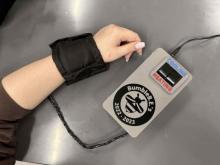Previous projects

Muscle soreness, joint injury, and chronic joint conditions are a common occurrence among many and can be debilitating, affecting one's ability to perform daily activities. Numerous devices have been designed to treat this pain; however, they often lack user control and only provide either heating or cooling - rarely both.
The purpose of this project is to design a low cost electromyography (EMG) controlled humanoid robotic hand. This reports primary objective is to provide a detailed review of the projects progress throughout the duration of Senior Design 1. A secondary objective of this report is to provide future project management plans for Senior Design 2. The customer requires the robotic hand to be capable of grasping a 3 inch diameter ball, or cup.
The purpose of this paper is to outline the design of a new high efficiency lower extremity exoskeleton. By reducing the weight and moment of inertia of an exoskeleton the efficiency can be drastically increased. Instead of powering 6 joints (hip, knee, and ankle) this system will allow operators to selectively power joints. This, along with a reduction in moment of inertia by relocating the actuators to the back of the operator will allow for a drastic boost in power efficiency.
As the new era of technology advances without boundaries, the more demand for intricate autonomous systems and human-like robots continues to increment. Soft robotics it’s a field of science and technology that is starting to bloom rapidly. The robotic soft actuator presented is able to manipulate speed, force and displacement the same as a voice coil actuator without having the same amount of stiffness and density-to-weight ratio. The project is overseen by Dr.
In recent years, research into bipedal robots and exoskeletons has been an exciting and rapidly growing field. Human augmentation, through the building of exoskeletons, is dependent on a deep understanding of how a human body operates on its own. The human body is very efficient at compensating for the various surface conditions it encounters when moving throughout the environment.
The purpose of this project is to develop a wheeled robot that, in a time of 1 minutes will either; (a) push your opponents’ robot out of a 3-foot diameter arena, or (b) disable your opponents’ robot.
Team ASTM has been tasked with designing a sumobot, which is a robot constructed and programmed to perform like a sumo wrestler in an arena competition. The primary objective of the competition is to push the opposition sumobot outside of the boundary line representing the arena before our team’s sumobot is pushed out of bounds.

